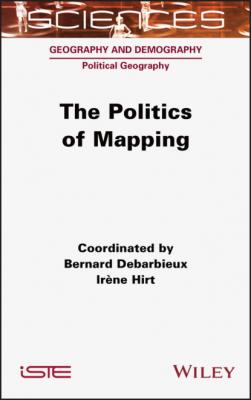ТОП просматриваемых книг сайта:
The Politics of Mapping. Bernard Debarbieux
Читать онлайн.Название The Politics of Mapping
Год выпуска 0
isbn 9781119986744
Автор произведения Bernard Debarbieux
Жанр География
Издательство John Wiley & Sons Limited
Calbérac, Y., Lazzarotti, O., Lévy, J., Lussault, M. (2019). Carte d’identités. L’espace au singulier. Hermann, Paris.
Chavinier, E. and Lévy, J. (2009). Minarets : malaise dans l’alteridentité. EspacesTemps.net [Online]. Available at: https://www.espacestemps.net/articles/minarets-malaise-dans-alteridentite.
Collignon, B. (2002). Les toponymes inuit, mémoire du territoire. Étude de l’histoire des Inuinnait. Anthropologie et Sociétés, 26(2–3), 45–69.
Debarbieux, B. (2015). L’espace de l’imaginaire. Essais et détours. Éditions du CNRS, Paris.
Desbiens, C., Rivard, É., Hirt, I. (2017). Nous nous souvenons du territoire : la géographie québécoise face aux mémoires autochtones. Cahiers de géographie du Québec, 61(173), 293–313.
Elden, S. (2013). The Birth of Territory. University of Chicago Press, Chicago.
Ferry, J. M. (1991). Les puissances de l’expérience : le sujet et le verbe. Le Cerf, Paris.
Foucault, M. (1977). Vérité et pouvoir : entretien avec Fontana, M. L’Arc, 70, 16–26.
Frelat-Kahn, B. and Lazzarotti, O. (2012). Habiter : vers un nouveau concept. Armand Colin, Paris.
Gibson, J.J. (1977). The theory of affordances. In Perceiving, Acting, and Knowing: Toward an Ecological Psychology, Shaw, R. and Bransford, J. (eds). Lawrence Erlbaum Associates Inc, Hillsdale.
Harley, B. and Woodward, D. (1987–2015). The History of Cartography. Chicago University Press, Chicago.
Harvey, D. (1969). Explanation in Geography. Edward Arnold, London.
Harvey, D. (1973). Social Justice and the City. Edward Arnold, London.
Hirt, I. (2012). Mapping dreams/dreaming maps: Bridging Indigenous and Western geographical knowledge. Cartographica, 47(2), 105–120.
Kant, E. (1785). Fondements de la métaphysique des mœurs [Online]. Available at: http://classiques.uqac.ca/classiques/kant_emmanuel/fondements_meta_moeurs/fondements.html.
Kant, E. (1798). Le conflit des facultés. In Opuscules sur l’histoire. Garnier-Flammarion, Paris.
Koseki, S.A., Lévy, J., Sartoretti, I. (2020). De l’espace pour l’école de la réussite. Zenodo [Online]. Available at: http://doi.org/10.5281/zenodo.3773955.
Lazzarotti, O. (2006). Habiter, la condition géographique. Belin, Paris.
Lévy, J. (1994). L’espace légitime. Presses de Sciences Po, Paris.
Lévy, J. (2014). Science + space + society: Urbanity and the risk of methodological communalism in social sciences of space. Geographica Helvetica, 69(2), 99–114.
Lévy, J. (ed.) (2015). A Cartographic Turn: Mapping and the Spatial Challenge in Social Sciences. EPFL Press, Lausanne.
Lévy, J. (2020). Ce dont on peut parler, il faut le dire. EspacesTemps.net [Online]. Available at: https://www.espacestemps.net/articles/ce-dont-on-peut-parler-il-faut-le-dire.
Lévy, J. and Chavinier, E. (2009). Malaise dans l’alteridentité. EspacesTemps.net [Online]. Available at: https://www.espacestemps.net/articles/minarets-malaise-dans-alteridentite/.
Lévy, J. and Sartoretti, I. (2018). Arts et sciences : le temps de l’hybridation. EspacesTemps.net [Online]. Available at: https://www.espacestemps.net/articles/arts-sciences-le-temps-de-lhybridation/.
Lévy, J., Poncet, P., Tricoire, E. (2004). La carte, enjeu contemporain. La Documentation française, Paris.
Lévy, J., Maitre, O., Pôvoas, A., Fauchille, J-N. (2017). Atlas politique de la France. Les révolutions silencieuses de la société française. Éditions Autrement, Paris.
Lévy, J., Fauchille, J-N., Pôvoas, A. (2018). Théorie de la justice spatiale. Géographies du juste et de l’injuste. Odile Jacob, Paris.
Lévy, J., Piantoni, S., Pôvoas, A., Renaud, E., Richelle, J., Schmitt, G. (2020). Topologies politiques. Espace politique et dynamique sociale après l’élection présidentielle américaine de 2020. EspacesTemps.net [Online]. Available at: https://www.espacestemps.net/articles/topologies-politiques/.
Monmonier, M. (2019). Comment faire mentir les cartes. Éditions Autrement, Paris [Original published 1991].
Raffestin, C., Lopreno, D., Pasteur, Y. (1995). Géopolitique et histoire. Payot, Lausanne-Paris.
Ricœur, P. (1990). Soi-même comme un autre. Le Seuil, Paris.
Robinet, A. (1957). Correspondance Leibniz-Clarke. PUF, Paris.
Rosa, H. (2019). Résonance. Une sociologie de la relation au monde. La Découverte, Paris.
Rudler, J. (2018). L’urbanisme de l’entre-deux. PhD Thesis, EPFL, Lausanne.
Sand, S. (2008). Comment le peuple juif fut inventé. Flammarion, Paris.
Sen, A. (2010). L’idée de justice. Flammarion, Paris.
Smith, N. and Williams, P. (1986). Gentrification of the City. George Allen and Unwin, London.
Soja, E. (2010). Seeking Spatial Justice. University of Minnesota Press, Minneapolis.
Spinoza, B. (1954). Éthique. Gallimard, Paris [Original published 1677].
Werlen, B. (1992). Society, Action, and Space. Routledge, London.
1 1 In many recent elections in the West, central areas of large cities have voted in a similar fashion, and so, have peri-urban (or in the case of the United States, suburban and ex-urban) areas. Gradients of urbanity defined by relative position within or outside urban areas (central, suburban/inner city, suburbia/peri-urban, hypo-urban/exurban, suburban) are strongly predictive of these votes. This is not an opposition between the metropolises and the rest of the territory, but a differentiation whose most striking features are the contrasts within the large urban areas. This regularity can be expressed in a formalized way through simple equations (see Lévy 2020).
Конец ознакомительного фрагмента.
Текст предоставлен ООО «ЛитРес».
Прочитайте эту книгу целиком, купив полную легальную версию на ЛитРес.
Безопасно оплатить книгу можно банковской картой Visa,

